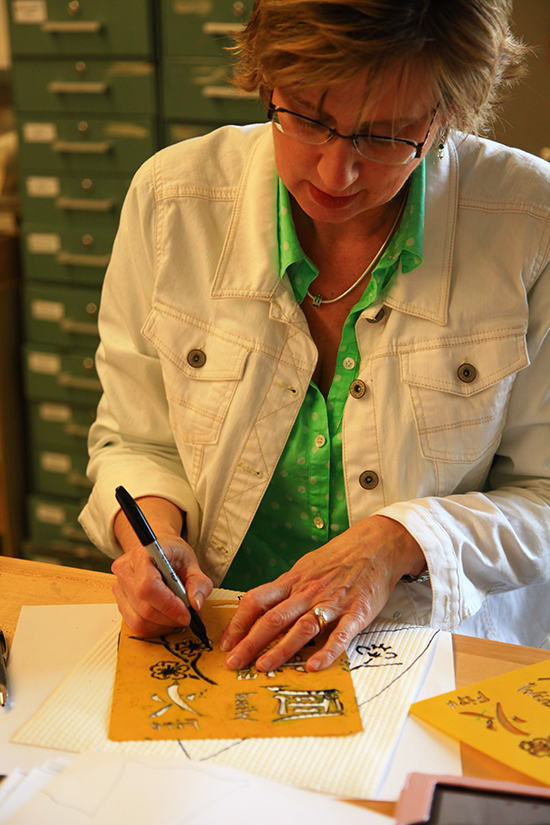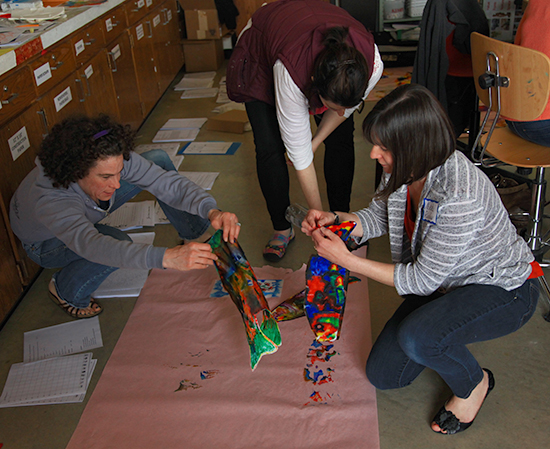Posted 9:18 p.m. Tuesday, Oct. 15, 2013

Heard of STEM? Learn about new partnerships on campus that are gaining STEAM.
 A participant in Leonardo’s Workshop, which launched the STEAMworks series. This educator works on hands-on math and science related activities at the workshop. Photo by Hanqing Wu.[/caption]
A participant in Leonardo’s Workshop, which launched the STEAMworks series. This educator works on hands-on math and science related activities at the workshop. Photo by Hanqing Wu.[/caption]
Workshop for educators slated Nov. 16
Integrating art and science to understand and create is not new. The Egyptians and the Greeks did it. In the last 100 years, Americans Frank Lloyd Wright and Louis Comfort Tiffany became famous for their ability to blend the biological world into their artistic designs. Separating the teaching of disciplines into distinct academic silos is a fairly modern concept, says Annette Valeo, outreach specialist with UW-La Crosse Continuing Education and Extension. But efforts to re-establish intersections between academic content areas are gaining steam among educators. UW-L has a history of interdisciplinary programming. The STEM Alliance was formed in 2008 by the School of Education to enhance the teaching and learning of science, technology, engineering, mathematics and related fields. The “STEAMworks” series of programs for educators will continue that tradition. Many are familiar with STEM — science, technology, engineering and math. STEAM recognizes art as an essential part of the mix. UW-L kicked off the STEAMworks series in May 2013 with Leonardo’s Workshop at UW-L’s Center for the Arts. It was aimed at K-8 teachers in all disciplines and offered ideas on teaching STEM subjects through art. The goal of STEAMworks is to build an ongoing series of STEAM-related programs on campus. The programs are geared to educators at all levels, from future teachers to Pre-K through 16 practicing professionals, and anyone interested in ways of thinking across disciplines to enhance learning. [caption id="attachment_27372" align="alignleft" width="550"] Educators pictured at Leonardo's Workshop in May 2013. Photo by Hanqing Wu.[/caption]
“We hope educators will leave with inspiration, ideas and connections with other educators that will allow them to use a multi-disciplinary approach in their classroom,” says Valeo.
A focus on integrating the arts in STEM has been gaining footing because of the need for creativity and innovation to solve problems and support global, economic and commercial movement forward in the 21st Century, says Valeo. When an engineer, scientist or artist approaches a problem, they share many commonalities on the road to finding a solution successfully, she adds. For instance, they all must be open to new outcomes, take risks, exercise persistence and not be afraid of failure. STEAMworks programs stress the importance of these core characteristics in effective problem solving, as well as other common strategies among disciplines.
[caption id="attachment_27375" align="alignleft" width="320"]
Educators pictured at Leonardo's Workshop in May 2013. Photo by Hanqing Wu.[/caption]
“We hope educators will leave with inspiration, ideas and connections with other educators that will allow them to use a multi-disciplinary approach in their classroom,” says Valeo.
A focus on integrating the arts in STEM has been gaining footing because of the need for creativity and innovation to solve problems and support global, economic and commercial movement forward in the 21st Century, says Valeo. When an engineer, scientist or artist approaches a problem, they share many commonalities on the road to finding a solution successfully, she adds. For instance, they all must be open to new outcomes, take risks, exercise persistence and not be afraid of failure. STEAMworks programs stress the importance of these core characteristics in effective problem solving, as well as other common strategies among disciplines.
[caption id="attachment_27375" align="alignleft" width="320"] Drawing by UW-L Biology Professor Tim Gerber.[/caption]
Biology Professor Tim Gerber, a co-leader of Leonardo’s Workshop, says STEAM is not only a concept he teaches to educators, but also something he uses regularly in his study of botany. For instance, illustrations of plants are a great way to accurately document the maximum information about a plant. Botanists have done it for centuries, he notes.
“One common feature in art and science is observation — period,” Gerber explains. “If you want to observe something, a good way is to make a drawing of it.”
STEAMworks is a collaborative effort of many departments across campus, which gives it strength, notes Valeo. Partners in the initiative include faculty and staff of the School of Education; College of Science and Health; School of Art and Communications, Office of Continuing Education and Extension and Murphy Library. Additional funding to support the programs has come from the Steinke Saterbak Fund.
Anyone can get involved. Faculty and staff are encouraged to report on any related initiatives in which they are involved. Programs are documented on a website originally developed by the STEM Alliance and updated last spring by Valeo. In addition to past and present STEM and STEAM programs, the site offers resources, articles and ways for people to connect to form STEAM partnerships on campus and beyond.
The next STEAM workshop “Teaching at the Intersection of Art and Science” is planned for Nov. 16 in Center for the Arts. Learn more.
Learn more on the STEAM website.
Drawing by UW-L Biology Professor Tim Gerber.[/caption]
Biology Professor Tim Gerber, a co-leader of Leonardo’s Workshop, says STEAM is not only a concept he teaches to educators, but also something he uses regularly in his study of botany. For instance, illustrations of plants are a great way to accurately document the maximum information about a plant. Botanists have done it for centuries, he notes.
“One common feature in art and science is observation — period,” Gerber explains. “If you want to observe something, a good way is to make a drawing of it.”
STEAMworks is a collaborative effort of many departments across campus, which gives it strength, notes Valeo. Partners in the initiative include faculty and staff of the School of Education; College of Science and Health; School of Art and Communications, Office of Continuing Education and Extension and Murphy Library. Additional funding to support the programs has come from the Steinke Saterbak Fund.
Anyone can get involved. Faculty and staff are encouraged to report on any related initiatives in which they are involved. Programs are documented on a website originally developed by the STEM Alliance and updated last spring by Valeo. In addition to past and present STEM and STEAM programs, the site offers resources, articles and ways for people to connect to form STEAM partnerships on campus and beyond.
The next STEAM workshop “Teaching at the Intersection of Art and Science” is planned for Nov. 16 in Center for the Arts. Learn more.
Learn more on the STEAM website.
